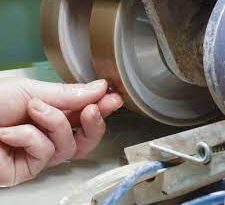Goldsmith: Chettinadu Jewellery
SECTOR: GEMS & JEWELLERY
SUB-SECTOR: Handmade gold and gems-set jewellery
OCCUPATION: Gold smithy (Specialised)
REFERENCE ID: G&J/Q0904
ALIGNED TO: NCO-2004/7313.28
Goldsmith-Chettinadu Jewellery: The Chettinadu Jewellery Goldsmith
makes heavy as well as traditional gold jewellery such as ‘Thali’ using
pure gold and alloys, and sets gemstones in close-set style.
Brief Job Description: The individual works with hand and machine tools
and using gold and polished gemstones to create traditional and heavy
Chettinadu jewellery, mostly acquired for investment or specific rituals.
Personal Attributes: The job requires the individual to have: aptitude for
design; attention to details; good eyesight; steady hands; strong
physique; ability to work for long hours in sitting position; and a lot of
patience. The individual must also be able to use reflective skills in order
to develop improved designs and work processes.
Unit Code G&J/N0901
Unit Title
(Task) Make components for Chettinadu Jewellery
Description This OS unit is about making different components required for making traditional
Chettinadu style of jewellery
Scope This unit/task covers the following:
Order precious metal or alloy for making components
Draw wire, strip or sheet
Anneal the wire or strip or sheet for malleability while drawing or rolling
Make components
Make components by stamping the gold sheet
Make the frame
File the frame components for finishing
Control precious metal loss
Detect product defects and return completed wire to supervisor
Report problems
To be competent, the user/individual on the job must be able to:
PC1. understand specifications in terms of required components, e.g., wires or
chains, sheets
PC2. assess the required quantity, size and weight of components for a heavy
Chettinad style jewellery, e.g., no of rings for a heavy chain
PC3. understand the dimensions and thickness requirement for each component
PC4. assess quantity of precious metal or alloy required for making the components
PC5. roll metal to the appropriate thickness using wire drawing or rolling machine
PC6. sharpen one end of the metal to ease the pass through of the metal in drawplate hole
PC7. push the metal through the draw-plate hole and then pull out
PC8. repeat the process through consecutive holes to get the required thickness of
wire
PC9. pass metal through roller machine or mill to make into strips or sheet of
appropriate thickness
PC10. ensure uniform thickness and weight while drawing wire for heavy jewellery
PC11. treat the wire or strip with heat using gas torch or furnace
PC12. set temperature according to the thickness of the wire or strip
PC13. remove the wire or strip from heat and quench in water to cool immediately
PC14. repeat the heating and cooling process after every drawing or rolling
PC15. solder the ends to shape as a ring
PC16. connect pieces of wire together to make the chain as per design using the
weaving or soldering method as specified
PC17. to make ball, cut the sheet or strip as per the diameter of the ball
PC18. create two hemispheres of the ball and lock and join them by heating
PC19. understand the design and stamping requirements for Chettinadu jewellery
PC20. assess number of similar components to be made as per design, e.g., different
various shapes required for Thali (Kaluthiru jewellery)
PC21. pick appropriate die of each component and fit it in the stamping machine
PC22. insert the sheet or strip drawn in the die machine and stamp the specified
design
PC23. ensure required number of similar components and different components are
stamped as per requirement
PC24. make components of required dimensions such as size and thickness
PC25. make components of required finish and evenness
PC26. draw or roll metal without overdrawing or splitting or cracking
PC27. anneal the wire, strips and sheets for required malleability for the thickness
required
PC28. make required number of different components as per design requirement of
Chettinadu jewellery
PC29. ensure that the rings are of uniform thickness and weight for making heavy and
thicker chain jewellery
PC30. assess the quantity and weight of different components required to make as
per jewellery requirement
PC31. check symmetry of design
PC32. lay the components and frame pieces on wax or lac and set in Plaster of Paris
(PoP) mixture or customised jigs
PC33. solder components to link to form frame as per design
PC34. remove PoP, level and strengthen joints in wax or lac
PC35. send completed frame for cleaning with brush and water or chemical solution
PC36. limit precious-metal loss of damaged metal rod or wire
PC37. accurately link the ends to form even rings, collets or chains of required
dimensions
PC38. link, solder and file the components into frame of required finish and utility
PC39. achieve required flexibility, utility and symmetry of frame as per design
PC40. cut any sharp edges as per design
PC41. file for smooth finish of joined periphery as per the design requirement
PC42. file or grind outer surface for smoothness and required finish
PC43. file for correct dimensions, e.g., length, bend, flexibility, colour, evenness, size
and embellishments to be fitted
PC44. meet productivity target
PC45. complete work with minimum hazards and accidents
Controlling precious
metal loss and
checking quality
To be competent, the user/individual on the job must be able to:
PC46. collect precious metal dust or fragments dispersed during the day
PC47. tally account as per allowed standards for wire making
PC48. conduct regular cleaning for collection of gold as per company policy
PC49. identify the type of defect, e.g., damaged beyond repair
PC50. handover defective components to supervisor for melting or use elsewhere
PC51. rework on any quality check feedback and return
To be competent, the user/individual on the job must be able to:
PC53. report machine failure
PC54. inform about tools shortage and their maintenance related issues
PC55. identify and report reasons for anticipated delays that may adversely affect
delivery
PC56. report malfunction of annealing torch or furnace
PC57. inform about poor quality of gold received
PC58. deliver complete frames in time by reporting well in advance, any problems
faced or anticipated
The individual on the job needs to know and understand:
KA1. company’s policies on: Acceptable limits of precious metal loss per product
type; delivery timelines; safety and hazards; security; and personnel
management
KA2. work flow involved in company’s jewellery manufacturing process, i.e., from
one goldsmith to another
KA3. importance of the individual’s role in the workflow
KA4. reporting structure
B. Technical
Knowledge
The user/individual on the job needs to know and understand:
KB1. uses of different types of tools for wire-drawing, stamping and rolling such as
ruler, draw plates, pliers, hammer, bench block, cup bur, cutter, roller
machine
KB2. properties of gold and gold alloy
KB3. different types of wax or lac and their use
KB4. different types of traditional Chettinad jewellery designs and their purpose
KB5. different components of used in traditional Chettinadu jewellery
KB6. procedure of making traditional components for Chettinadu jewellery, e.g.,
Thali components do not require linking by soldering
KB7. precious-metal or gold alloy properties such as strength and malleability
KB8. heat treatments and intensity effect with respect to different types of gold
alloys
KB9. potential work hazards, particularly, when using hand and machine tools
Skills (S) [Optional]
A. Core Skills/
Generic Skills
Basic reading and writing skills
The user/individual on the job needs to know and understand how:
SA1. to read notes and put notes on design
Measuring skills
The user/individual on the job needs to know and understand how:
SA2. to assess the material requirement for making wires of specified length and
thickness
SA3. to use gauge check the thickness of wire
SA4. to check symmetry of component made
The user/individual on the job needs to know and understand how:
SA5. to assess the number of components required as per design
SA6. to assess the weight and size requirement for each component e.g., number
of rings and weight of each ring for making a heavy gold chain
B. Professional Skills Using tools and machines
The user/individual on the job needs to know and understand how:
SB1. to use roller machine for drawing wire or strip
SB2. to use tools for drawing wire such as: Gas torch or furnace for annealing wire
or strip; drawing tongs and draw plate for thinning diameter of wire and
required shape; wax or oil for lubrication
SB3. to use tools such as files and pliers
SB4. to use stamping machine for making components through readily available
die
SB5. to use the right hole in draw plate and at correct angle for achieving the finish
as per design
SB6. to maintain tools and machines used
SB7. to use technology such as computer for visual aid and efficient working
Reducing precious metal loss
The user/individual on the job needs to know and understand:
SB8. prescribed precious-metal loss for the entire jewellery piece
SB9. Precious-metal loss applicable for the component
SB10. how to reduce precious metal loss below the prescribed standards
SB11. how to collect broken or over rolled pieces, account in job sheet and return
SB12. how to follow company’s policies on collecting gold dust and fragments
SB13. how to suggest improvements in order to reduce precious metal loss limits
Reflective thinking
The user/individual on the job needs to know and understand how to:
SB14. work in sitting or standing for long hours position with correct posture
SB15. maintain clean work environment and organise tools for ease of use
Critical thinking
The user/individual on the job needs to know and understand how:
SB16. to spot process disruptions and delays
SB17. to avoid hazards when using roller machine or draw plate or during annealing
G&J/N0804
Unit Title
(Task) Set gemstones using closed setting technique
Description This OS unit is about setting gemstone using close setting technique. i.e., closing the
jewellery on one side with gold sheet and then setting the gemstones
Scope This unit/task covers the following:
Receive sorted diamonds, gemstones and jewellery components for gemstone
setting
Close the jewellery before setting
Set gemstone in the jewellery frame
File excess gold around gemstone set and ensure smooth finishing
Detect product defects and self-check quality
Report problems
To be competent, the user/individual on the job must be able to:
PC1. receive the gemstones for setting
PC2. understand different shapes, sizes and colour of stones
PC3. match stones with design
PC4. understand the close setting requirement in terms of shape and size and depth
PC5. drill holes in the jewellery using drilling machine at an angle as per specification
to hold the gemstones
PC6. close the back side of the jewellery using a gold sheet by soldering, e.g., for
bangle, the inner side is closed by covering by a gold sheet and soldering
PC7. file or grind outer surface for smoothness and required finish
PC8. file for correct dimensions and design , e.g., length, bend, flexibility, colour,
evenness, size and embellishments to be fitted
Gemstone setting To be competent, the user/individual on the job must be able to:
PC9. prepare the collet by etching the closed hole to the required depth and
dimensions
PC10. pick the gemstones using appropriate twisters or tongs for easy placement in
the hole drilled
PC11. place the gemstone in the hole and bezel it in to secure firmly
PC12. repeat for other holes as per jewellery design
PC13. file or cut sharp edges in jewellery
PC14. grind for smooth surface on the surface after bezelling
PC15. avoid over filing
PC16. achieve flawless setting as per design requirement
PC17. achieve even colour of stones set, i.e., no discolouration or breakage during
setting
PC18. set stones securely using bezelling
PC19. avoid damage to the rest of the frame during the process of setting
PC20. achieve productivity as per target
PC21. complete work with minimum hazards and accidents
Checking quality To be competent, the user/individual on the job must be able to:
PC22. inform supervisor if product has arrived with polishing, cleaning, filing or linking
defect from previous processes
PC23. understand the type of defect and send to relevant goldsmith
PC24. check visually in for any defects such as loose stone, tilted setting, marks, blank
spaces
PC25. check weight and dimensions of jewellery as per design
PC26. remove and re-set stone again if returned from QC achieve flawless setting as
per design requirement
Reporting problems To be competent, the user/individual on the job must be able to:
PC27. report tools shortage and their maintenance related issues
PC28. identify and report reasons for anticipated delays that may adversely affect
delivery
PC29. deliver stones set jewellery in time by reporting problems faced or anticipated
well in advance
The individual on the job needs to know and understand:
KA1. company’s policies on: Acceptable limits of gold loss per product type;
delivery timelines; safety and hazards; security; and personnel management
KA2. work flow involved in company’s jewellery manufacturing process (from one
goldsmith to another)
KA3. importance of the individual’s role in the workflow
KA4. reporting structure
B. Technical
Knowledge
The user/individual on the job needs to know and understand:
KB1. sorting similar shapes and size of stones as per design
KB2. 4Cs, i.e., colour, cut, clarity and carat
KB3. handmade jewellery making process
KB4. types of soldering technique to close the jewellery on one side
KB5. types of close set jewellery and setting techniques
KB6. bezelling technique of gemstone setting and method of setting them securely
in the jewellery
KB7. uses of different types of tools and techniques for gemstone setting
KB8. different types of gemstones and their characteristics
KB9. different types of wax and their use in jewellery making
KB10.basic properties of gemstones and effect of reaction to pressure, heat and
chemicals
KB11. gold alloy properties for securing and rework, i.e., which alloy allows rework
KB12.filing and soldering
Basic reading and writing skills
The individual on the job needs to know and understand how:
SA1. to read notes and put notes on design
SA2. to use technology such as computer for visual aid or improving efficiency
Measuring and Geometry skills
The individual on the job needs to know and understand how:
SA3. to assess precious metal loss at each step of jewellery making so as to deliver
product of correct weight and size
SA4. to translate design into gems-set jewellery
SA5. to set the stone into drilled hole at correct angle for secure and tilt-free placing
Teamwork and multitasking
The individual on the job needs to know and understand how:
SA6. to share work load with other setters as per capability and work load
SA7. to deliver frame to next work process on time
B. Professional Skills Reading design
The individual on the job needs to know and understand how:
SB1. to set stones as per design
SB2. to spot difficulties with respect to practicality of design
Using tools
The individual on the job needs to know and understand how:
SB3. to use the right hand tools for achieving secure setting as per design
SB4. to use tools so that they do not damage jewellery frame or gemstones
SB5. to use tools such as: hammer, tweezers, graver, scoop, wooden plates with lac,
gas torches, table light, needles, burrs, files and soldering system
SB6. to understand safety and hazards involved in using tools
Reducing precious-metal and stone loss
The user/individual on the job needs to know and understand:
SB7. prescribed precious-metal and stone loss for the entire jewellery piece
SB8. precious-metal loss applicable for setting
SB9. how to reduce precious-metal and stone loss below the prescribed standards
SB10. how to follow company’s policies on collecting gold dust and fragments
SB11. how to account in job sheet and return
SB12. how to suggest improvements to reduce precious-metal and stone loss limits
Reflective thinking
The individual on the job needs to know and understand how:
SB13. to improve work processes
SB14. to work with good posture in a sitting position
SB15. maintain clean work environment and organise tools for ease of use
Critical thinking
The individual on the job needs to know and understand how:
SB16. to spot process disruptions and delays
G&J/N9910 Maintain IPR and respect copyright
Unit Code G&J/N9910
Unit Title
(Task) Respect IPR of company as well as competitors
Description This OS unit is about maintaining company’s IPR and avoiding infringement on
copyright of others
Scope This unit/task covers the following:
Protect company’s Intellectual Property Rights (IPR)
Avoid infringement to copyright of other companies
Performance Criteria(PC) w.r.t. the Scope
Element Performance Criteria
Respecting IPR To be competent, the user/individual on the job must be able to:
PC1. prevent leak of new designs to competitors by reporting on time
PC2. spot any infringement of company’s product or design patents
PC3. report IPR violations observed in the market, to supervisor or company heads
PC4. read copyright clause of the material published on the internet and any other
printed material
PC5. consult supervisor or senior management when in doubt about using publicly
available information
PC6. report any infringement observed in the company
PC7. spot plagiarism and report
PC8. understand rationale of patents and IPR
PC9. avoid being involved in IPR violations
Knowledge and Understanding (K)
A. Organizational
Context
The individual on the job needs to know and understand:
KA1. company’s policies on IPR, plagiarism and order leaks
KA2. company’s patented products
KA3. market trends and company’s unique product range
KA4. reporting structure
B. Technical
Knowledge
The individual on the job needs to know and understand:
KB1. basics of patents and IPR laws
KB2. how IPR protection is important for competitiveness of a company
Skills (S) [Optional]
A. Core Skills/
Generic Skills
Communication skills
The user/individual on the job needs to know and understand how:
SA1. to effectively communicate any observed IPR violations or design leaks
B. Professional Skills Decision making
The user/individual on the job needs to know and understand when and how:
SB1. to report sources of IPR violations
National Occupational Standard
G&J/N9910 Maintain IPR and respect copyright
16
Reflective thinking
The user/individual on the job needs to know and understand how:
SB2. to learn from past mistakes and report IPR violations on time
Critical thinking
The user/individual on the job needs to know and understand how:
SB3. to spot signs of violations and alert authorities in time
Unit Code G&J/N9912
Unit Title
(Task) Interact with colleagues and seniors
Description This OS unit is about communicating with colleagues and seniors in order to maintain
smooth ad hazards free work flow
Scope This unit/task covers the following:
Interact with supervisor
Interact with colleagues within and outside the department
Performance Criteria(PC) w.r.t. the Scope
Element Performance Criteria
Interaction with
supervisor
To be competent, the user/individual on the job must be able to:
PC1. receive and understand work instructions from reporting superior
PC2. communicate to reporting supervisor about process flow improvements,
product defects received from previous process, repairs and maintenance of
tools and machinery as required
PC3. communicate any potential hazards or expected process disruptions
PC4. handover completed work to supervisor
PC5. understand the work output requirements
PC6. comply with company policy and rule
PC7. deliver quality work on time as required by reporting any anticipated reasons
for delays
Interactions with
colleagues and other
departments
To be competent, the user/individual on the job must be able to:
PC8. work as a team with colleagues and share work as per their or own work load
and skills
PC9. work with colleagues of other departments such as frame making or
component making or polishing or setting or stores
PC10. communicate an discuss work flow related difficulties in order to find solutions
with mutual agreement
PC11. receive feedback from QC and rework in order to complete work on time
PC12. put team over individual goals
PC13. resolve conflicts and multi-task
Knowledge and Understanding (K)
A. Organizational
Context
(Knowledge of the
company /
organization and
its processes)
The individual on the job needs to know and understand:
KA1. company’s policies on personnel management
KA2. work flow involved in company’s jewellery manufacturing process
KA3. importance of the individual’s role in the workflow
KA4. reporting structure
National Occupational Standard
G&J/N9912 Coordinate with co-workers
20
B. Technical
Knowledge
The individual on the job needs to know and understand:
KB1. how to communicate effectively
KB2. how to build team coordination
Skills (S) [Optional]
A. Core Skills/
Generic Skills
Teamwork and some multitasking
The individual on the job needs to know and understand how:
SA1. to share work load as required
SA2. to deliver product to next work process on time
B. Professional Skills Decision making
The individual on the job needs to know and understand:
SB1. how to report potential areas of disruptions to work process
SB2. when to report to supervisor and when to deal with a colleague depending on
the type of concern
Reflective thinking
The individual on the job needs to know and understand:
SB5. how to improve work process
Critical thinking
The individual on the job needs to know and understand:
SB6. how to spot process disruptions and delays
Unit Code G&J/N9914
Unit Title
(Task) Work towards having a safe work environment
Description This OS unit is about being aware of and communicating potential hazards and
dangers of accidents on the job
Scope This unit/task covers the following:
Understand potential sources of accidents
Communicate to reporting supervisor about hazards in time
Performance Criteria(PC) w.r.t. the Scope
Element Performance Criteria
Understanding of
potential sources of
accidents and
communicating
To be competent, the user/individual on the job must be able to:
PC1. avoid accidents related to use of potentially dangerous chemicals, gas torches,
sharp tools and hazards from machines
PC2. suggest process flow improvements to reduce anticipated or repetitive hazards
PC3. report mishandling of tools, machines or hazardous materials
PC4. identify electrical problems that could result in accident
PC5. spot and report potential hazards on time
PC6. follow company policy and rules regarding hazardous materials
PC7. deliver quality work on time as required by reporting any anticipated reasons
for delays
Knowledge and Understanding (K)
A. Organizational
Context
(Knowledge of the
company /
organization and
its processes)
The individual on the job needs to know and understand:
KA1. company’s policies on handling: harmful chemicals and sharp tools, safety and
hazards of machines, fire safety and, disposal of harmful chemicals and
materials
KA2. work flow involved in company’s jewellery manufacturing process
KA3. importance of the individual’s role in the workflow
KA4. reporting structure
B. Technical
Knowledge
The individual on the job needs to know and understand:
KB1. how different chemicals react and what could be the danger from them
KB2. how to use machines and tools without causing bodily harm
KB3. fire safety education
KB4. disposal of hazardous chemicals, tools and materials by following prescribed
environmental norms or as per company policy
Skills (S) [Optional]
A. Core Skills/
Generic Skills
Communication skills
The individual on the job needs to know and understand how:
SA1. to effectively communicate the danger
National Occupational Standard
G&J/N9914 Maintain safe work environment
24
B. Professional Skills Decision making
The individual on the job needs to know and understand:
SB1. importance of reporting potential sources of danger
SB2. appropriate actions to be taken in the event of an accident
SB3. process for disposing of hazardous materials, safely and following
environmental guidelines
Reflective thinking
The individual on the job needs to know and understand how:
SB4. to learn from past mistakes regarding use of hazardous machines or
chemicals or gas torches
Critical thinking
The individual on the job needs to know and understand:
SB5. how to spot danger
SB6. procedures to follow in the event of a fire or other hazard
Keywords /Terms Description
Sector Sector is a conglomeration of different business operations having similar
business and interests. It may also be defined as a distinct subset of the
economy whose components share similar characteristics and interests.
Sub-sector Sub-sector is derived from a further breakdown based on the
characteristics and interests of its components.
Occupation Occupation is a set of job roles, which perform similar/ related set of
functions in an industry.
Function Function is an activity necessary for achieving the key purpose of the
sector, occupation, or an area of work, which can be carried out by a
person or a group of persons. Functions are identified through functional
analysis and form the basis of OS.
Sub-function Sub-functions are sub-activities essential to fulfil the achieving the
objectives of the function.
Job role Job role defines a unique set of functions that together form a unique
employment opportunity in an organisation.
Occupational Standards
(OS)
OS specify the standards of performance an individual must achieve
when carrying out a function in the workplace, together with the
knowledge and understanding they need to meet that standard
consistently. Occupational Standards are applicable both in the Indian
and global contexts.
Performance Criteria Performance criteria are statements that together specify the standard of
performance required when carrying out a task.
National Occupational
Standards (OS)
NOS are occupational standards which apply uniquely in the Indian
context.
Qualifications Pack (QP) QP comprises the set of OS, together with the educational, training and
other criteria required to perform a job role. A QP is assigned a unique
qualifications pack code.
Unit Code Unit code is a unique identifier for an Occupational Standard, which is
denoted by an ‘N’
Unit Title Unit title gives a clear overall statement about what the incumbent
should be able to do.
Description Description gives a short summary of the unit content. This would be
helpful to anyone searching on a database to verify that this is the
appropriate OS they are looking for.
Scope Scope is a set of statements specifying the range of variables that an
individual may have to deal with in carrying out the function which have
a critical impact on quality of performance required.
Knowledge and
Understanding
Knowledge and understanding are statements which together specify the
technical, generic, professional and organisational specific knowledge
that an individual needs in order to perform to the required standard.
Organisational Context Organisational context includes the way the organisation is structured
and how it operates, including the extent of operative knowledge
managers have of their relevant areas of responsibility.
Technical Knowledge Technical knowledge is the specific knowledge needed to accomplish
Definitions
Qualifications Pack For Goldsmith- Chettinadu Jewellery
27
specific designated responsibilities.
Core Skills/ Generic
Skills
Core skills or generic skills are a group of skills that are the key to learning
and working in today’s world. These skills are typically needed in any
work environment in today’s world. These skills are typically needed in
any work environment. In the context of the OS, these include
communication related skills that are applicable to most job roles.
Keywords /Terms Description
IPR Intellectual Property Rights
NOS National Occupational Standard(s)
NVQF National Vocational Qualifications Framework
NSQF National Qualifications Framework
NVEQF National Vocational Education Qualifications Framework
QP Qualifications Pack








